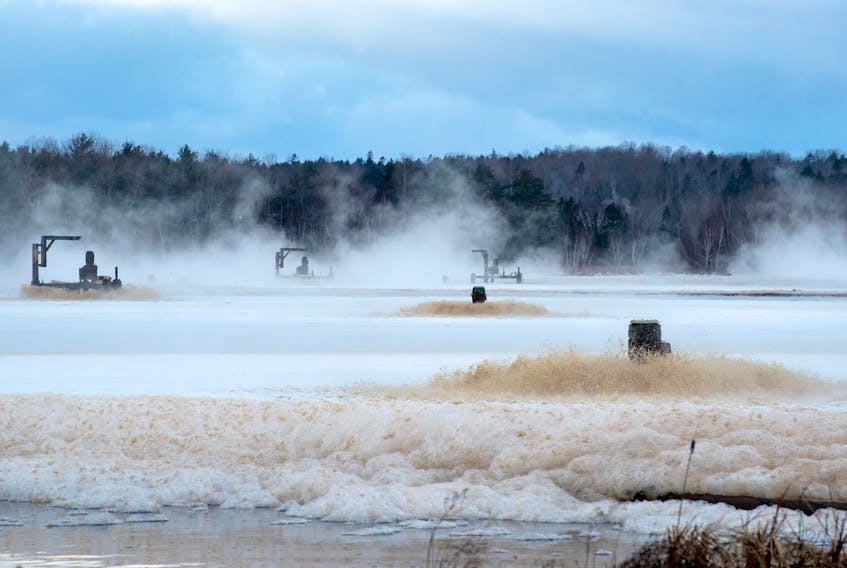ABERCROMBIE POINT - Northern Pulp is hoping a new land-based system to treat and dispose of effluent from its Pictou County mill will clean up more than just the water.
The company aims to distance itself from years of controversy over the outdated system that sent effluent into a treatment lagoon next to Aboriginal land in Boat Harbour.
Northern Pulp plans to switch from an aerated stabilization basin process in Boat Harbour to an activated sludge treatment process that will treat mill wastewater at a new, more compact facility on company property, then pump it directly into the Northumberland Strait through a pipeline.
According to Guy Martin, principal consultant for process and environment with KSH Solutions, once the new system is in place, effluent will be sent to a smaller basin where solids will be removed.
“We’re collecting the effluent at the same place in the pumping system, but rather than taking it to Boat Harbour, we will intercept the line and send it to a primary clarifier,” explained Martin.
The catch basin will have diffusers and oxygen, which will be sent to the bottom rather than the surface of the pond, reducing the smell, he said.
“It’s the same principle, done in a more compact fashion. From there, (it's) pumped up the hill, and...through a series of heat exchangers,” said Martin.
“Rather than rely on surface aerators that mechanically splash around the effluent to cool it and inject air, we’re going to do it through indirect cooling.”
That means heat exchangers in a series of cooling towers. The effluent will be pumped through one side, while cooling water will be pumped through the other side. According to Martin, this process would allow the effluent to be cooled without being exposed to the atmosphere again to reduce smell.
These towers will reduce the amount of water needed for the process, he added.
The new treatment system differs, though, in that it uses microorganisms that break down material in the mill effluent in eight to nine hours. Some of the treated sludge is sent back into the system.
Martin said the system will send “a population of microorganisms that know the effluent, like it, and eat it to teach the other microorganisms how to eat it.” This is what “activates” the sludge in the system.
The treated effluent will be carried to the Northumberland Strait by a flexible 36-inch diameter high-density polyethylene line resting on the bottom of Pictou Harbour.
According to information released from Northern Pulp, the line will rest on a layer of stone (a rock mattress), and will be covered with armour-stone for protection where needed.
“We have to get some data right now, and want to be able to determine the entire length of the pipe and how that’s going to work,” said Martin. “The pipe will have a manifold with six nozzles coming up at an angle, to diffuse the effluent into the strait.”
Terri Fraser, technical manager and project lead for the replacement facility with Northern Pulp, said the pipeline is a big portion of the cost of the project.
“Of course, from the mill perspective and the cost perspective, we want to have the shortest pipeline we can,” she said.
The line will have six diffusers at the end built like “duck bills,” controlling the volume of effluent released into the outfall zone.
Picking the best course for a pipeline requires data about currents and the terrain at the bottom of the strait. That is being gathered using an underwater camera, and through a series of studies on water flow, officials explained.
These models used in the studies are said to take into account sensitive areas, such as fisheries and habitat areas for wildlife and identified the Northumberland Strait as the best outfall area because it best meets the guidelines of the Canadian Council of Ministers of Environment. They require effluent emissions match background conditions within 100 metres of the diffuser.
Fraser said the disposal system was designed with the “most conservative, worst-case scenario” in mind, accounting for an effluent outflow of 85,000 cubic metres per day – far above the average.
Meanwhile, inside the mill, Northern Pulp is installing an oxygen delignification system (also known as “oxygen bleaching”), which will help reduce the use of bleaching chemicals to whiten the pulp created at the mill as the pulp progresses through the system.
The pipeline has been under fire by local environmentalists and members of the fishing community, who are concerned about the impact of what will come out of the line. Protests have been held in the past few months to express opposition to the project.
Some opponents have called for a closed-loop system in which all effluent waste would be cleaned and reused in the plant, basically eliminating the need for the pipeline. However, both the mill and experts experienced with this type of bleached kraft pulp method have indicated a closed loop system would not work due to the process.









